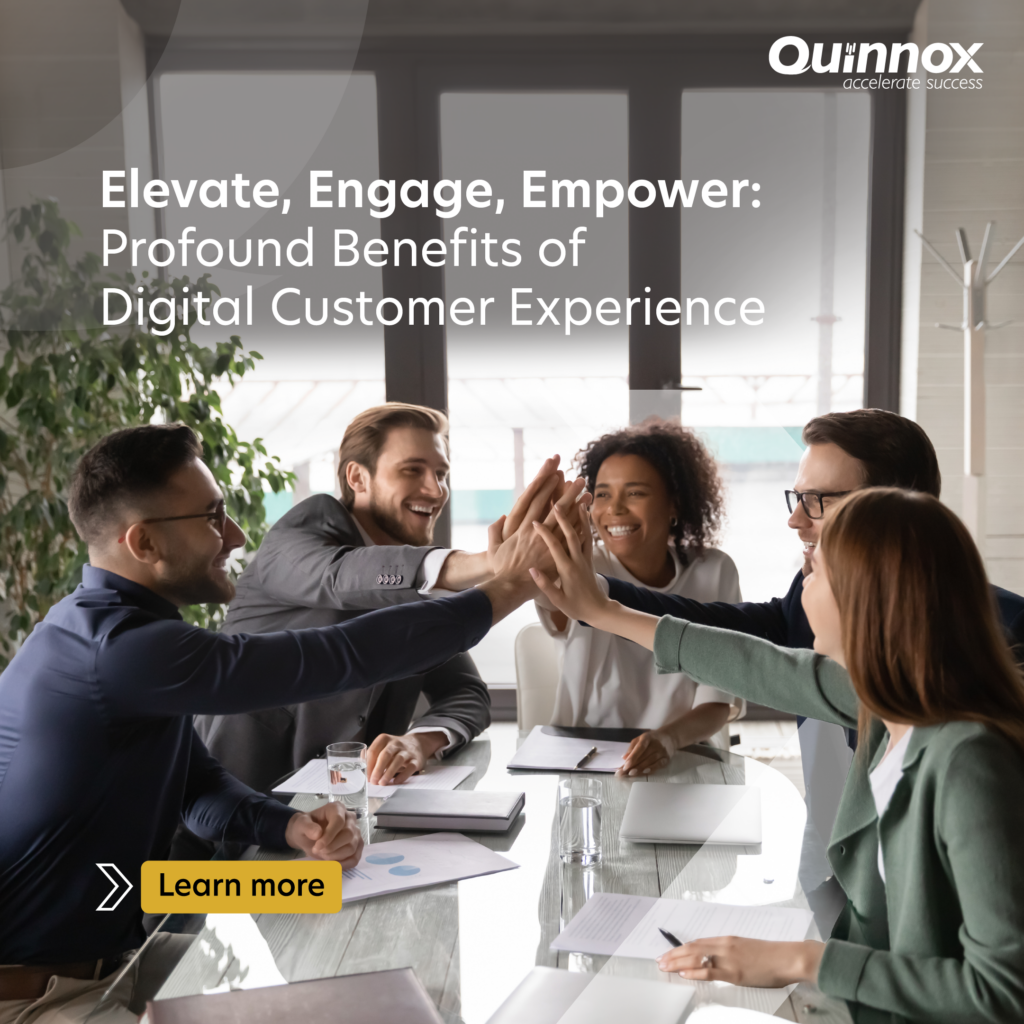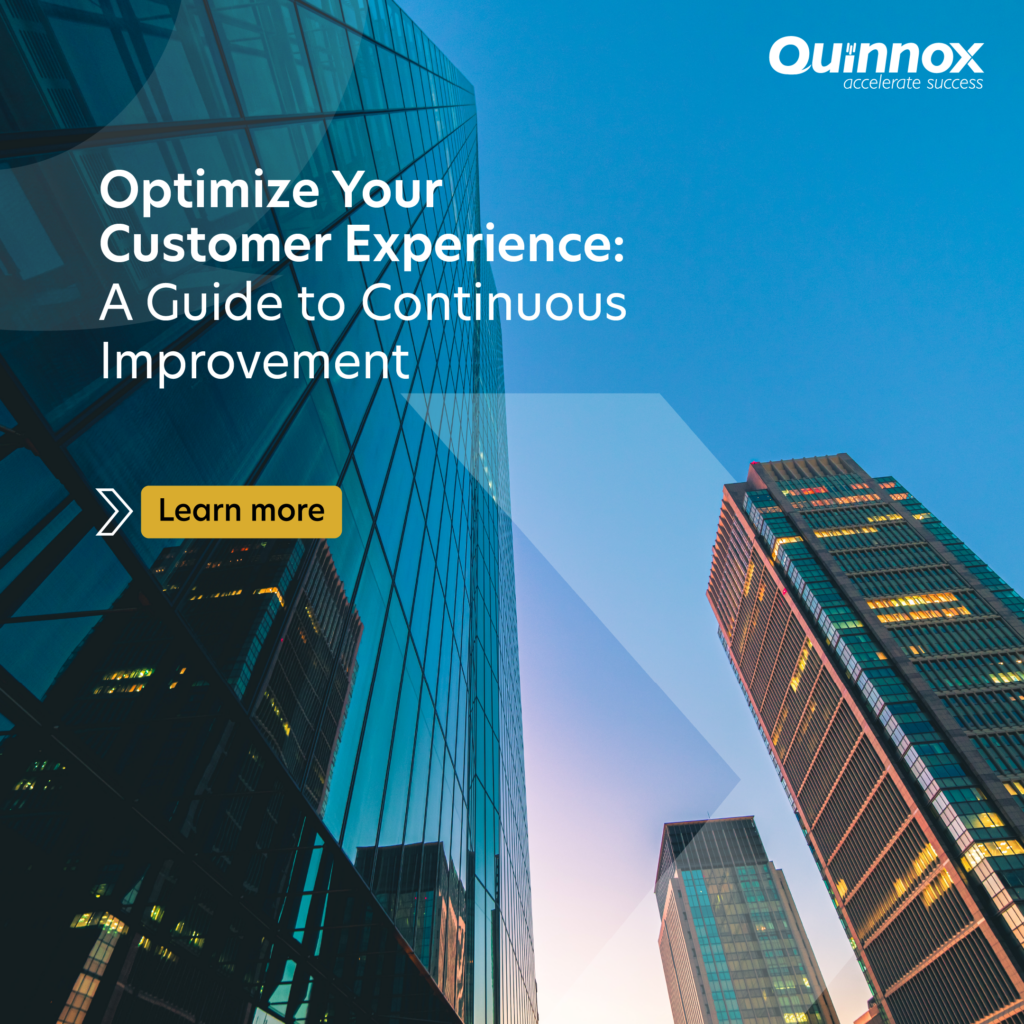“The purpose of a business is to create and keep a customer.” – Peter Drucker
According to PWC, 73% of customers cite a good experience as a key purchase factor, and a single negative review can cost a business of up to 30 customers. In an age where customer loyalty is a currency more valuable than ever, the imperative to enhance Customer Experience (CX) is non-negotiable.
Yet, the paradox is intriguing – more than 50% of businesses struggle to deliver seamless customer experiences as they still rely on outdated legacy systems that are slow, inefficient and offer limited functionalities.
But fear not, in this blog, we will elaborate more on these challenges and provide insights on how legacy modernization can help enterprises pave the way for a better customer experience.
Modernizing Legacy Systems for Better CX:
Elevate your business’s customer experience by taking the first crucial step: moving from legacy systems to a modern operational system. Embrace agility and innovation, ensuring your organization aligns seamlessly with customer expectations in the ever-evolving digital era. Unlock a future of enhanced CX and sustained success.
Why Customer Experience Matters to You?
Source: Bain and Company
- Businesses that prioritize CX report a 130% higher return on investment (ROI) than those that don’t
- Businesses with superior customer experience generate up to 17% higher customer lifetime value.
- Improving customer retention by just 5% can increase profits by 25% to 95%
- Promoters (satisfied customers) generate 53% more revenue than detractors (unhappy customers).
What hinders a Seamless Customer Experience?
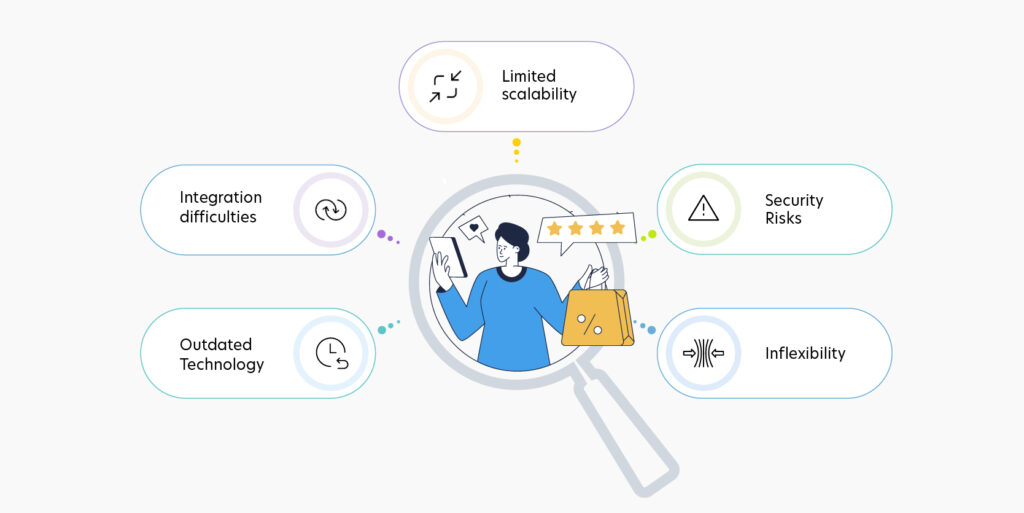
As Bill Gates once noted, “Your most unhappy customers are your greatest source of learning.” This rings particularly true when legacy systems result in slower response times and an inability to meet the dynamic expectations of today’s customers.
Integration difficulties, a hallmark of legacy systems, further compound the issue, making it challenging to integrate with newer technologies and platforms. This lack of integration hampers the flow of data and information across different touchpoints, leading to disjointed and inconsistent customer interactions. The struggle with limited scalability becomes apparent as businesses grow and evolve, hindering their ability to handle increasing customer demands and data volumes. Cybersecurity risks add another layer of concern, with aging systems being more susceptible to vulnerabilities, potentially compromising customer data. Inflexibility is the final blow, as legacy systems often struggle to adapt to changing market trends and customer preferences, resulting in a slower time-to-market for new features or services.
These challenges emphasize the urgency for businesses to move away from legacy systems, as they not only hinder customer experience but also jeopardize brand loyalty and market competitiveness.
CXO Pain Points: Navigating the DCX Minefield
- Omnichannel disconnect
- Data silos and lack of insights
- Legacy systems and infrastructure
- Resistance to change and siloed thinking
The integration of emerging technologies, such as artificial intelligence (AI) and machine learning, poses a significant challenge for CXOs. While these technologies hold immense potential to enhance customer experiences, the complexity of implementation and the fear of data breaches can hinder their adoption.
CXOs also face the challenge of ensuring a consistent and personalized customer journey across multiple channels, as customers today expect seamless interactions whether they’re online, on a mobile app, or engaging with a company in person.
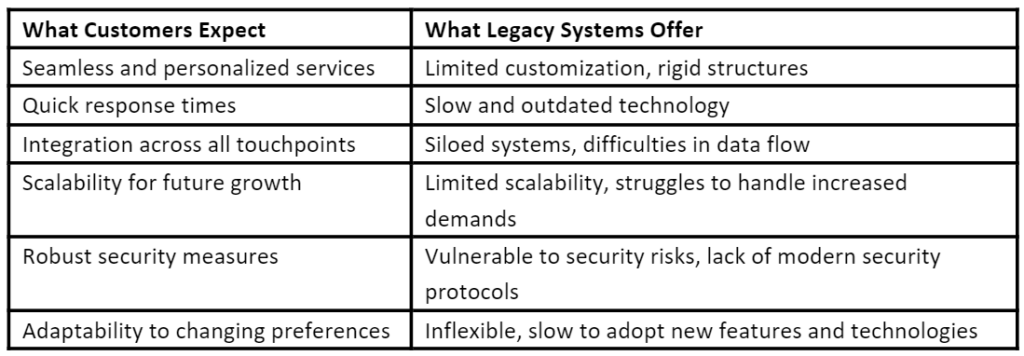
Modernization: Unlocking a Path to Continuous CX Improvement
Certainly! Modernization of legacy systems is a critical step toward achieving continuous improvement for seamless Customer Experience (CX).
1. Agile Development and Continuous Deployment:
- Frequent Updates and Releases: Modernizing legacy systems often involves adopting agile development methodologies and continuous deployment practices. This allows organizations to release updates and improvements to the CX more frequently and efficiently. Rather than large, infrequent releases, agile development enables continuous deployment of smaller, incremental changes, addressing issues promptly and introducing new features seamlessly.
- Rapid Response to Customer Feedback: Continuous improvement is fueled by customer feedback. Modernized systems, with agile processes in place, can quickly respond to customer comments, complaints, and suggestions. Organizations can use this feedback to prioritize and implement changes that directly impact the customer experience. Regular updates based on customer input contribute to an ongoing cycle of improvement.
2. Real-Time Analytics and Monitoring:
- Performance Monitoring: Modernized systems are equipped with real-time monitoring and analytics tools that track system performance, user interactions, and potential bottlenecks. By continuously monitoring the system, organizations can identify and address issues promptly, ensuring a consistently high level of performance. This proactive approach prevents disruptions and contributes to a smooth CX.
- User Behavior Analysis: Consumer Analytics tools integrated into modern systems allow organizations to analyze user behavior in real-time. By understanding how customers interact with the system, businesses can identify pain points, preferences, and areas for improvement. This data-driven approach enables organizations to make informed decisions for enhancing the overall CX.
3. Scalability and Flexibility:
- Elastic Infrastructure: Modernizing legacy systems often involves moving to scalable and flexible cloud-based infrastructure. This allows organizations to scale resources up or down based on demand. During periods of increased activity, such as promotions or peak seasons, the system can automatically allocate additional resources, ensuring a seamless experience for customers even under high loads.
- Adaptability to Changing Requirements: Legacy systems are often rigid and struggle to adapt to evolving business requirements. Modernization enables the development of systems that can easily evolve and adapt to changing customer needs and market trends. This adaptability ensures that the CX remains relevant and aligned with the dynamic nature of the business environment.
FedEx’s modernization efforts involve transitioning to cloud-based logistics platforms. By leveraging cloud infrastructure, FedEx can scale its operations dynamically, adapting to fluctuations in demand. This scalability ensures timely deliveries and a smoother customer experience, especially during peak shipping seasons.
4. Integration of Emerging Technologies:
- AI-Driven Automation: Modernized systems can leverage artificial intelligence (AI) for automation, improving efficiency and reducing manual interventions. Automated processes, such as chatbots for customer support or predictive analytics for anticipating customer needs, contribute to a smoother CX. The integration of AI enables continuous refinement of these automated services, learning from user interactions and adapting over time.
- IoT Integration: Internet of Things (IoT) devices can be integrated into modern systems to collect real-time data about customer interactions with products or services. This data can be used to improve personalization, enhance product features, and address any issues customers may encounter. The continuous stream of data from IoT devices facilitates ongoing
5. Cross-Functional Collaboration:
- Collaboration Between IT and Business Units: Modernization efforts often involve breaking down silos between IT and business units. Cross-functional collaboration ensures that technology solutions align with business goals and customer needs. This collaborative approach fosters a culture of continuous improvement, where both technical and non-technical teams work together to identify and implement enhancements to the CX.
- Iterative Prototyping and Testing: Modernization allows for the adoption of iterative development processes, including prototyping and testing. This approach involves creating prototypes of new features or improvements, automated testing them with real users, and incorporating feedback before full implementation. This iterative cycle ensures that changes are refined based on real-world user experiences, contributing to a continuously improving CX.
JPMorgan Chase’s mobile app allows customers to start a mortgage application on their smartphones and seamlessly continue or complete the process at a branch. This cross-channel coordination enhances convenience and improves the overall banking experience.
The Journey to CX Excellence through Modernization:
Modernization is not a one-time event but an ongoing journey. Here’s a roadmap to navigate this journey effectively:
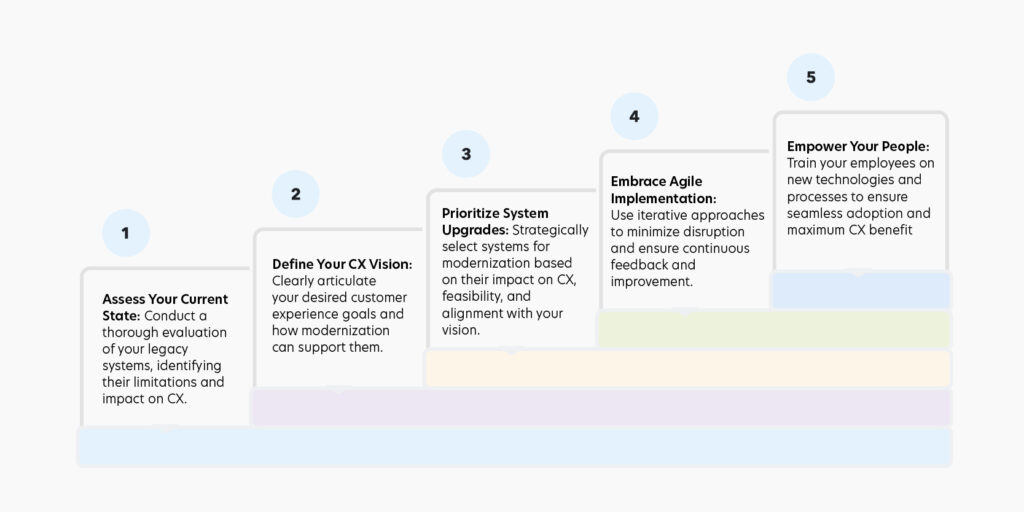
Your Continuous Improvement with Quinnox: The Key to Lasting Success
Modernization is not just about replacing old systems; it’s about creating a culture of continuous improvement. By fostering a data-driven approach, actively seeking customer feedback, and embracing agile practices, you can ensure your CX evolves alongside customer expectations.
At Quinnox, we understand the challenges of modernizing legacy systems and the transformative power of CX modernization. We offer a comprehensive suite of services from legacy system assessment to data-driven insights and optimization to help your businesses navigate this journey and drive sustainable business growth
Remember, Modernization is an investment in your customer relationships, your brand reputation, and your long-term success. By breaking free from the constraints of legacy systems, you can unlock the full potential of CX and create a journey that truly delights your customers.
Connect with Us Today!
Explore more on elevating your customer experience journey!


